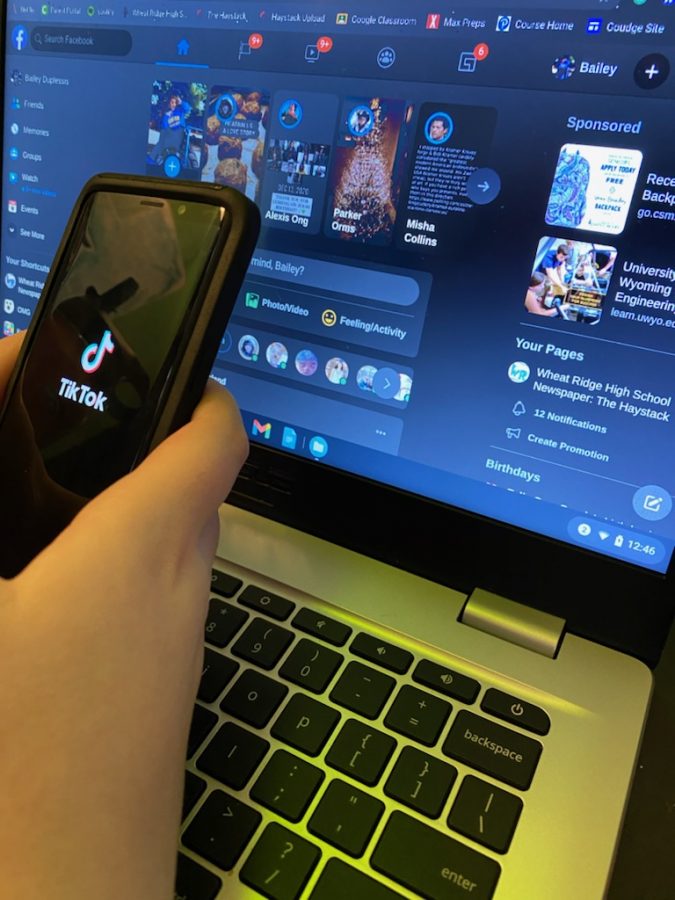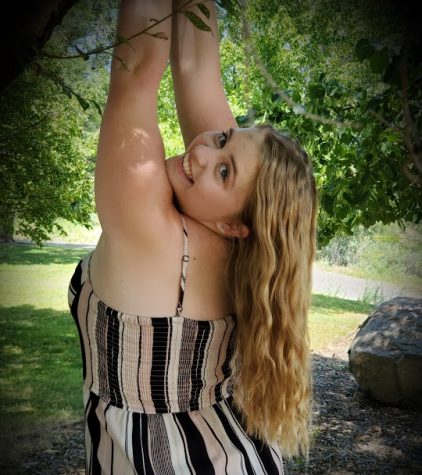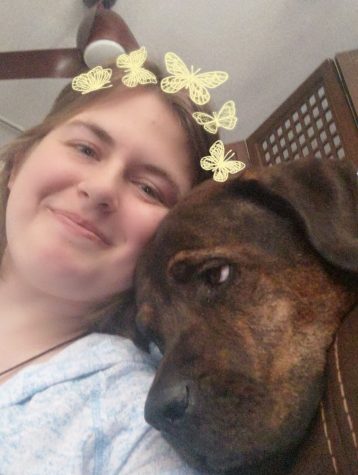The Haystack Takes On No Social Media
Instead of doing homework, teen watches TikTok while on Facebook
December 15, 2020
We all know that social media is the new way of life. It’s how we keep in touch with friends and family, how we find out about the latest news and the latest trends.
Most don’t see a downside to social media, or they just don’t want to see a downside. According to ABC News in 2019, teenagers (13-18) spend an average of seven hours and 22 minutes on their phones every day.
By now, it’s known that 2020 has been a wild year. Most people use social media more than ever to keep in contact with their loved ones and friends. The average amount of time in 2020 spent on social media per day is about two and a half hours. Just eight years ago in 2012, people only spent an average of an hour on social media. Tiktok is one of the most popular social media apps of all time, with 800 million active users. Users spend an average of 45 minutes per day scrolling through the “For You” page.
Four of the Haystack staff writers took on a small challenge to see how their algorithms of their social media would react with no activity for 48 hours. And how they would react. One of the included is Bailey Duplessis, the Social Media Director for the Haystack. She is joined by staff writers Al White, Leo Humphrey, and Keally Peck.
This idea arose with the watching of the Netflix Original, The Social Dilemma. This is a documentary/drama hybrid that talks about all of the wild things that social media does to us and the people around us. They talk to social media geniuses, people behind the scenes of social media, and people who have studied the effects of social media for years.
Duplessis, Humphrey, White, and Peck started at noon on Dec. 9, 2020, and ended on Dec. 11, 2020, at the same time. Here are their stories.
Bailey Duplessis, Senior: This experiment was a real eye-opener. I definitely saw that I was addicted to social media. I found myself getting really upset quicker and just feeling a sense of anger after about 24 hours into it. I found myself being bored and mindlessly clicking into Facebook and I noticed right away and would close the app. I totally just deleted Snapchat after the first accidental click.
I did a lot to keep myself busy, though. I caught up on all of my school work, got my Christmas presents made (I made tie-dyes for friends and family), and even picked up an extra shift at work.
I did find myself stressed with not knowing if someone texted me, or if I was missing out on the next TikTok trend. My total screen time over the 48 hours was less than six hours– and that was just playing games and being on Facetime with friends while keeping myself entertained.
My average screen time per day beforehand was about six and a half hours. I didn’t see that my algorithm was changed a whole lot. I just got more suggested stuff I was looking up for school rather than personal things. I find myself only checking my Snapchat to people I actually want to talk to and only spending a couple of minutes each on Instagram and Facebook at a time. TikTok is what I need to get better with.
Overall, I liked this experiment, I highly suggest it. I will also be limiting my screen time by a lot more and setting time limits for apps.
Al White, Junior: While this experiment was not too much of a challenge for me, there were some things that stood out. My social media algorithm did not change much, as we did not spend enough time off of the platforms to cement a real change. I did, however, see the effects of social media addiction within myself during this time.
I was about 30 minutes into the experiment and already I had opened up Snapchat. I realized that I did not care who had sent me a Snap but that I just wanted to get the notification off my Home Screen. This was a common occurrence throughout the duration of the 48 hours. When I was waiting in line for something, whether it be food or at the store, I wanted to check my Instagram feed to pass the time.
TikTok is another platform that I use to pass time when I’m bored, and I caught myself almost opening the app on my phone multiple times.
All in all, the experience I had opened my eyes to how addicted to social media I am. I have continued this “social media cleanse” past the end time of the experiment and have seen a rise in productivity within myself. I also checked my average time spent on my phone daily, with a total of six hours and 45 minutes..
Keally Peck, Senior: When the challenge first began, I was not bothered by it much. I spent most of my day either doing school, reading, or catching up on movies I hadn’t watched in a while. It wasn’t until the notifications flooded in and when my family would try and show me updates, trying to test me on the challenge, that I began to feel off.
It felt weird not checking my phone first thing in the morning to check social media, whether it be to see how my family and friends were doing on Facebook, or to see what Tik Tok was up to on those particular days.
I’m not as social media obsessed as some people as well, so this challenge didn’t seem like it was the death of me either. I don’t have Twitter, or Snapchat, or Instagram, which didn’t make this challenge seem like I was shutting my entire world down either.
With this challenge, I also discover I spend on average four hours and 53 minutes on my phone, which is not as much compared to social media celebrities, or those who know social media more than their own lives. So, for the most part, the challenge was a good way for me to see how big of an impact I had with two days of no social media and made me realize there are other ways to spend your time rather than just endlessly checking social media.
Leo Humphrey, junior: For the first day of no social media, it honestly wasn’t too difficult.The only times I wanted to get on YouTube were when I remembered a funny video from a few years ago. That being said it wasn’t easy all the time.
The second day, which was our first full day, came as less of a challenge. I think it might be because we are closing in on finals and we have plenty of work to keep us busy. After about three hours into the second day, I turned off notifications for almost all of my apps. Turning off notifications was a big help.
Music was the biggest help for this project. It helped me get past the urges of Instagram and YouTube and kept me focused on my work. After a while I hadn’t even thought about social media; I felt a lot more at ease. My theory for this is that I’m not being constantly overloaded with information, some of which isn’t even true.
When it comes to how I felt mentally after the experiment, I felt actually pretty good, although I did miss memes. The overall just pure distress I was having really opened my eyes to what my phone was doing to me. I have deleted nearly all of my social media.
The biggest thing I noticed though from this experiment was what happened next, after the experiment I started to fall behind in a few classes. I did feel more distracted getting on social media again. Time really flies quickly on a screen.
My final takeaway is that I’ll be limiting my screen time to around three hours a day, and I’ll be adding guides to help me with that.
The Haystack Insights
Overall, each of the four staff writers had different and similar experiences with this. Each of them came to the conclusion that they are going to be limiting screen time and time spent on social media. If the reader of this article takes anything away, it’s to get off of social media and go spend time with family and do some stuff around the house that you have been putting off. And watch The Social Dilemma on Netflix.



